Auckland Plan for the ninety-nine percent
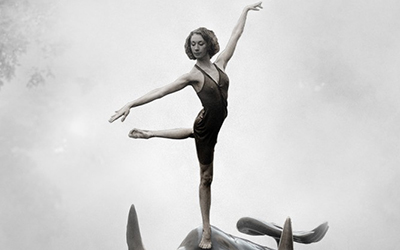
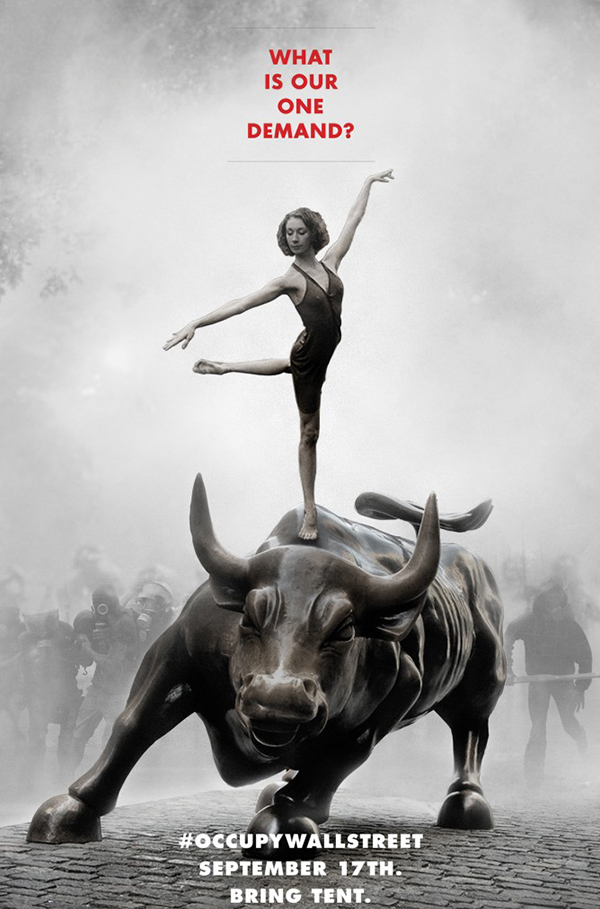
Leading the Way: The global movement that puts the planet and 99% of the people ahead of the interests of Wall Street has arrived, and not a moment too soon. Poster Adbusters
The wonder is that it took quite so long, to be occupied.
Had it happened as he was being elected, President Barack Obama would have been presented with a mandate to save the planet rather than Wall Street. Instead, the grassroots revolt is happening on the eve of the president’s probable re-election, and the money that should have been poured into green growth has been blown bailing out a patently undeserving and fundamentally flawed financial sector—much as has happened in Aotearoa.
Albeit slow-burning, it is bizarre that the bailout of Wall Street has been the catalyst for a global grassroots movement. The far bigger affront to humanity is the lack of global action in the face of graphic evidence of human-made global warming. With Earth’s land surface only 1° warmer (since 1950) and the atmosphere 4% more moist, extreme rainfall events are pummelling many parts of the planet causing unprecedented death, destruction and economic ruin. Launching Migration and Global Environmental Change, chief scientific adviser to the British government Professor Sir John Beddington warns:
Since 2008, on average, 25 million people a year have been displaced by extreme weather events, and that’s in a world of relatively benign climate change.
The 2008– recession/depression is but a symptom of the cycle of economic and population growth, consumption and greed that was never sustainable on a planet of so obviously finite resources. But rather than the shortage of fresh water, minerals and agricultural land delineating the limits of growth, the limited ability of the atmosphere to absorb carbon dioxide without producing a hostile climate has proved to be the sustainability crunch point.
With its chapter titled Auckland’s Response to Climate Change and plans elsewhere for public transport, the Draft Auckland Plan has some distinctly encouraging content. This was reinforced on Monday by Mayor Len Brown running the possibility of a referendum on tolls and congestion charges up the city hall flagpole. However, the rationale given by the mayor for raising $10 billion over the next 30 years for transport reveals a disconcerting preoccupation with reducing congestion, rather than reducing the need for physical transport. While rail is clearly preferable to motorway in regard to greenhouse gas emissions, much need for transport can be avoided by better and greater use of fibre-optic cabling.
Had 1950s Aucklanders not been so utterly beguiled by the motorcar, a rail and pedestrian only harbour bridge could have set the city on a vastly more sustainable trajectory. Sir Dove-Myer Robinson’s visionary advocacy of rapid transit in the 1970s would have been assured, and the Third Labour Government of New Zealand presumably would not have reneged on its promise to support it.
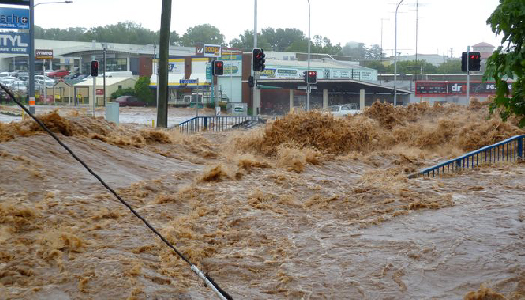
Plain Truth: While the mainstream media shamelessly reports extreme weather events, it is shamefully reticent in reminding its audience it is staring into the fearful face of global warming. photographer Nicole Hammermeister Toowoomba 10 January 2011
Mayor Brown cites the failure to support Sir Dove-Myer’s initiative as something that must not be repeated now. But the mayor is similarly mired in the past—technology today offers smarter and greener alternatives to trains, and at a fraction of the $10 billion mooted. Rather than play catch up, the city can make a virtue of its past failure to build rail infrastructure by skipping that greener but hugely expensive phase, and instead maximising the considerable opportunity to move, where appropriate, work to the people, not people to the work. In this model, in addition to having the option of working full or part time from home, workers would walk or cycle to shared offices located within their local community.
Meanwhile, the government’s submission unflinchingly reflects private enterprise ideologue Transport Minister Joyce’s belief that the Auckland Council’s job is to provide more roads for the boys, determinedly ignoring the mayor’s specific mandate for public transport.
By taking a leaf out of the Green Party’s election pamphlet, the Auckland Plan could be subtitled: For a Richer Region. The mayor’s foreword could then set out a strategy for the region to become one of the most desirable places on Earth to live, because of its quality of life. Forget the goal of Auckland being Aotearoa’s economic powerhouse, past experience has proven that that this results in the increasing income inequality that Dame Anne Salmond, writes of:
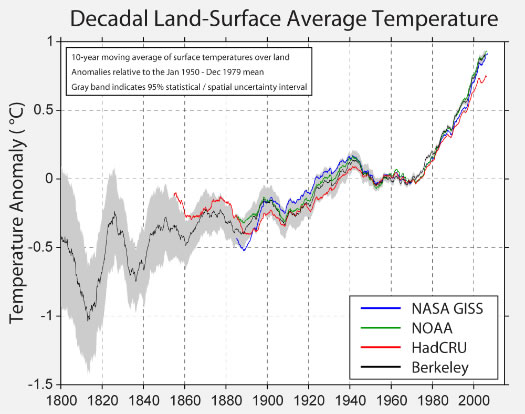
BEST Evidence to Date: ‘The decadal land-surface average temperature using a 10-year moving average of surface temperatures over land. Anomalies are relative to the January 1950 – December 1979 mean. The grey band indicates 95% statistical and spatial uncertainty interval.’ image Berkeley Earth Surface Temperature Study
In the midst of successive financial crises, the hand of the market still harvests wealth for the wealthy. While the richest avoid taxation, billions can be found to shore up the corporate sector, but not to deal with child poverty, third-world diseases, high rates of youth incarceration and suicide, and other indicators of suffering and failure.
Provided that they are accessible by public transport, regional parks represent an imminently palatable and practicable means of redistributing wealth. At virtually no cost folk can spend a day—or a week, where there is provision for camping—living like the 1%; the owners of multimillion-dollar coastal spreads. And their greenhouse gas emissions are probably less than if they’d stayed at home. Then home might more reasonably be the higher-density living the draft plan calls for, with no need of motorised mowers and weed trimmers, or cars.
Mahurangi and Wenderholm epitomise the potential for regional park accessibility. The southern extent of the parkland is the Waiwera River, and the spa town at it mouth is the northern terminus of a public transport system serving nearly 1.5 million people. At present, few people walk the short distance to Wenderholm, much less continue to explore the balance of the parks’ 10 kilometres of contiguous coastline. For a very modest expenditure, the Pūhoi River could be crossed with a combination of boardwalk and pivot bridge—the likes of which once crossed the Pūhoi farther north, as part of the Great North Road. In comparison, the bridge across Te Muri would simply need to provide clearance for the kayaks and dinghies that occasionally venture up the estuary at the top of a tide. Combined with the already popular backpack camping sites at Te Muri and Mita Bay, and backed by nearly nine hundred hectares of parkland where park users can enjoy as much or as little company as they crave.
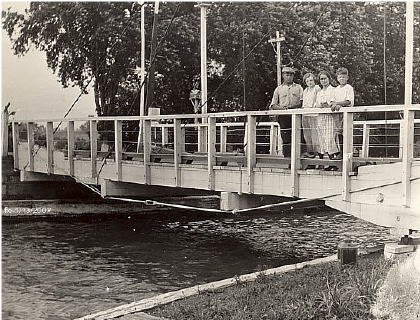
Pivotal Infrastructure: With a bridge similar to this example on the Chesapeake and Delaware Canal, the Great North Road once crossed the Pūhoi, while allowing scows and steamers access by pivoting the span horizonatally through 90°. Image courtesy Jeanne Harmon
More ambitiously, an electric-powered ferry could operate from the northern limit of the 10-kilometre coastal trail, across the harbour to Scotts Landing. This would place the Mahurangi–Matakana wine district within a morning’s walk of Waiwera and public transport.
Before Wenderholm was purchased, Waiwera was the northern-most destination for large numbers of day‑trippers from the metropolis—a quarter of a million, the year before the park opened. The famed mineral pools, then, represented an easily affordable family outing. The more affluent ordered scones, jam and cream and hired a sun umbrella for their picnic table, if they’d arrived sufficiently early to claim one. But most brought picnic lunches, had their teapots filled for sixpence, and spread their picnic blankets somewhere on the acres of lawn available. In the early 1970s the owner briefly raised the admission charge by 10 cents, but price-control authorities intervened and returned it to 40 cents. A family with four or more children could spend the day there for less than the equivalent of today’s discounted price for one student: $20. Patrons could to come and go all day—a privilege that children in particular enjoyed, alternating plunges in the hottest pools with joyous dashes into the ocean.
Leaving aside whether or not, after a century and a half of sometimes culpably indifferent private ownership, the pools should now be operated for the public benefit, in January, when announcing an investigation into the feasibility of providing free admission to council-owned swimming pools the mayor said:
Free access to swimming pools is a great gift to our young people, somewhere local to go and have fun, to be active and to get off the streets. Auckland is surrounded by water, and it is critical our kids learn to be safe and confident around it.
The response of conservative councillors was immediate and predictable. Meantime, directive 10.10 of the Draft Auckland Plan states:
Maintain and extend the public open space network, sporting facilities, swimming pools, walkways and trails for Aucklanders now and in the future…
Along with libraries, that this infrastructure is admission-free should be implicit.
